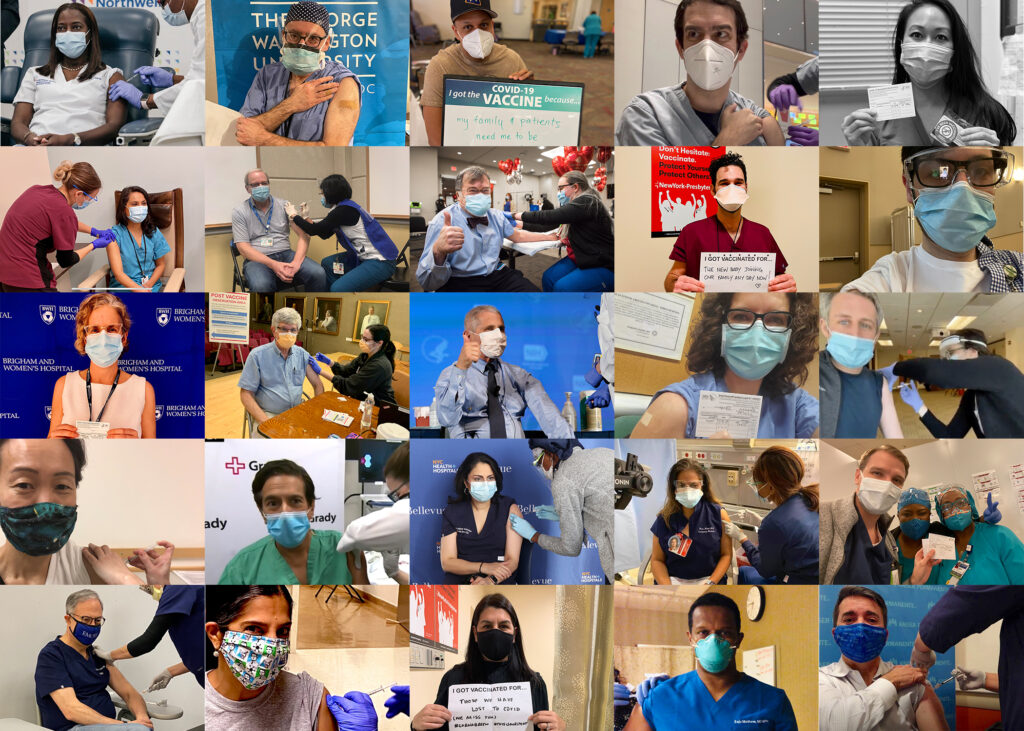Welcome back to Week 38 in my weekly reports analyzing the Covid-19 pandemic and its effects on the country and higher education, and happy new year to all. For those of you reading this on my blog, Off the Silk Road, I have also launched a newsletter, where these reports can be sent directly to your email each week. Click here to subscribe.
Last week, we examined the latest round of data before the holiday season. This week, most of our discussion will focus around two critical issues: the new variant first discovered in the UK and the Trump administration’s failed vaccine rollout.
A national look
We begin this week’s update mourning the passing of Congressman-elect Luke Letow, who died from Covid-19 at the age of 41, just days before his swearing-in. We send our condolences to his family during this most difficult time.
This week marks a year since the WHO was notified of a pneumonia of an unknown cause in Wuhan.
In less than two months, the U.S. has doubled its total number of infections, facing exponential spread. December was the deadliest month of the pandemic. While areas in the Midwest have seen case counts decline from the early fall, California continues to be in absolute crisis, with hospitals literally running out of oxygen. This map shows which hospitals have seen the largest increase of confirmed and suspected Covid-19 patients between the weeks of December 11 and December 18 (from latest HHS facility-level data). Areas of concern are California (continued), but also Arizona and some New York hospitals.
Due to data lags from the holidays, it will be difficult to track the complete impact of holiday gatherings until 7-10 days from now. However, we can use data from other states in the summer to track the impact of restrictions placed to curb infections. Evidence from 6 other states that imposed restrictions from the summer and fall may be able to give us insights on when California may see a decline in cases (barring the effects of holiday gatherings, since those did not exist in the summer). Using data from these states that imposed various restrictions in the summer, we see the mean number of days from restrictions imposed to peaks are 12.3 days for cases, 17.5 days for hospitalizations and 27.3 days for deaths. These data show that it is possible to “flatten the curve” and emphasis must be placed by policymakers on residents that such a pause is only temporary.
The president continues to show no effort towards controlling the pandemic, choosing to spend his time undermining American democracy. New reporting from The New York Times further underscores his disdain towards widespread testing. “You’re killing me! This whole thing is! We’ve got all the damn cases,” Mr. Trump yelled at Jared Kushner, his son-in-law and senior adviser, during a gathering of top aides in the Oval Office on Aug. 19. “I want to do what Mexico does. They don’t give you a test till you get to the emergency room and you’re vomiting.”
So what does 2021 have in store for the pandemic? The Atlantic’s Ed Yong reports: “The virus now has so much momentum that more infection and death are inevitable as the second full year of the pandemic begins. ‘There will be a whole lot of pain in the first quarter’ of 2021, Dr. Anthony Fauci, the director of the National Institute of Allergy and Infectious Diseases, told me.” The CDC’s latest projections are now a staggering 424,000 deaths by January 23.
Let’s take a look at some of the latest scientific developments:
- Much of this week’s scientific discussions revolved around two new variants of the coronavirus: One first discovered in the UK and the other first discovered in South Africa. Three U.S. states have reported cases of the new UK variant: Colorado, California and Florida. A new paper from Imperial College London estimates that the new variant adds between 0.36 and 0.68 to R, the virus’ reproductive number. That would mean, on average, every person infected with B.1.1.7 infects an extra 0.36 to 0.68 persons compared to earlier variants. It is possible that this variant spreads more easily due to early results that show people may carry more virus in their noses. Other data show that the variant is more dominant in children and seems to have continued to cause transmission during Britain’s lockdown, while other strains slowed down. We must continue to study this variant, as early results show it may not be very common in the U.S. yet. However, if it takes hold it will spread very easily and would also result in increased fatalities with more transmission chains. We must also remember that the same precautions (masks, distancing, hand hygiene) will still work against all variants.
- Researchers at Johns Hopkins University found that people who hosted or traveled for Thanksgiving were 2.5x more likely to receive a Covid-19 positive test afterwards compared to those who stayed home.
- A preprint studying 3,762 individuals with “Long Covid” showed that most had not returned to previous levels of work by 6 months following infection. Many patients are not recovered by 7 months, and continue to experience significant symptom burden.
- An NIH study drew attention to the possibility, but rarity of reinfection with Covid-19. Out of 133,266 laboratory-confirmed SARS-CoV-2 cases, 243 people (0.18%) had at least one subsequent positive swab ≥45 days after the first-positive swab. Of these, 54 cases (22.2%) had strong or good evidence for reinfection. The median time between first and reinfection swab was 64.5 days.
- Results from a Chinese CDC study found that nearly half a million residents in Wuhan were infected with Covid-19 with an antibody prevalence rate of 4.43%. Other cities outside Wuhan had significantly lower prevalence rates.
- A preprint by NIH scientists suggests that face masks have properties to lower the severity of disease as they increase the humidity of air one breathes in, making it harder for virus to be transmitted.
- A study published in Clinical Infectious Diseases on the Abbott BinaxNOW rapid test showed 100% and 98.5% sensitivity (relative to PCR+) at Ct thresholds of 30 and 35, respectively.
- A CDC report found that of the people exposed to Covid-19 cases and quarantined with a negative test on day 7, 19% experienced symptoms or received positive test results in the following week. This underscores that a shorter quarantine after household exposure to Covid-19 might be easier to adhere to, but poses some risk for onward transmission.
- Results from tests using the Quidel antigen test at two Wisconsin colleges published in a CDC report found that rapid tests may have a high false negative rate. For symptomatic individuals, the test had an 80.0% sensitivity and 98.9% specificity. For asymptomatic individuals, the test had an 41.2% sensitivity and an 98.4% specificity. The study suggests a confirmatory test with PCR.
Finally, some updates on vaccines.
- Novavax has started its Phase 3 trials in the U.S.
- As the UK and India have approved the AstraZeneca vaccine for emergency use, Operation Warp Speed’s Moncef Slaoui said Americans likely won’t receive AstraZeneca’s coronavirus vaccine before April due to lingering questions about its effectiveness in certain groups.
- Senator Mitt Romney lambasted the administration’s lack of a vaccine plan and provided suggestions on how to conduct an efficient rollout, including scheduling slots based on people’s birthdays, bringing out retired medical professionals and erecting mass vaccination sites.
- China has approved its Sinopharm vaccine for emergency use, which according to limited company data has an efficacy rate of 79%.
- Much vaccine discussion has revolved around recent decisions in the UK, where officials have decided to delay the second dose for individuals and has also changed its vaccine playbook to permit mixing first and doses among companies. Scientists are divided on the topic — I’d recommend you read this compilation of threads for their thoughts. Currently, Dr. Fauci has said the U.S. will not delay the 2nd dose for individuals, vaccinating people as intended.
- As I mentioned on Twitter on Thursday, the CDC has now released state-level data for vaccine distribution and administration. This now means that my Vaccine Allocation Dashboard will no longer be updated on a daily basis. You can find the CDC’s data here.
As the U.S. crossed the 20 million case mark, the Trump administration promised 20 million vaccine doses would be administered by December 31. They failed miserably, with only 2.6 million doses administered before the end of the year, according to the CDC. Currently, the number of doses administered stands at 4.2 million, with over 13 million doses distributed. As I explained on Twitter earlier this week, the ratio of doses administered to distributed is the most important statistic we can use to monitor vaccine distribution. Currently, the U.S. has administered only 32% of its distributed doses.
What are the reasons behind the slow vaccine rollout (besides lags in data reporting)?
- FDA quality control
- Production
- State distribution (reaching communities and coordinating allocations)
Like every aspect of this pandemic, the Trump administration has failed to come up with a nationwide vaccine rollout plan, instead leaving it up to individual states, who already have limited public health resources and inadequate funding. In the words of Dr. Peter Hotez, Dean of the National School of Tropical Medicine at Baylor College of Medicine, “It’s almost like dropping off 40 million boxes of Ikea furniture and realizing after the fact that assembly is required.” Some states, such as Oklahoma and Florida, have left vaccine distribution up to individual counties, who have chosen to use platforms such as EventBrite and SignUpGenius for vaccine slots (yes, the same way you buy concert tickets — it is most likely not secure enough for HIPAA-compliant patient information). In the last week, we have also received reports of incidents such as one worker deliberately placing vaccine doses out of the fridge and ruining them, one facility giving people antibody treatments instead of vaccines and another giving vaccines to close contacts.
“Unlike with other botched aspects of the pandemic response…the officials at Operation Warp Speed knew the nation required a logistics effort never before attempted,” The Washington Post editorial board writes. “Yet instead of warp speed, the rollout has begun at a saunter.” Before we discuss any questions of changing the dosing regimen of our vaccine distribution, we must solve our vaccination administration issues. We need to be erecting mass vaccination sites, training medical professionals for vaccinations and increasing the efficiency of putting shots in arms. Every moment delayed will cost lives, and the Trump administration will continue to face increased deaths with a slow vaccine rollout. We can also expect the pace of vaccinations to pick up, as similar programs often start at a slow pace. We will continue our discussion on vaccine rollout in the coming weeks, proposing new solutions and analyzing existing ones.
Let’s move on to our (short) discussion of higher education.
Higher education
Here’s a roundup of this week’s higher ed news (due to the holiday period, there was less news reported):
- Emerson College is the latest school to begin the spring semester remotely.
- The Washington Post reports on the necessity of living in dorms for some students on campuses this fall. “I would be really uncomfortable if I were home,” one senior at Penn said.
- The pandemic blocked real-life pool time for the MIT’s graduation requirement of a swim test, so the school created a conceptual class to take it virtually.
- A review of more than 400 complaints about partying and public health violations at the University of Illinois shows the impact of partying and social gathering was far wider than previously recognized.
- A recent economics study published in The New York Times offers new insight into how to design effective financial rewards programs that could work especially well for college students. One suggestion is to pay students if they continue to test negative.
As we approach the spring semester, we will be presenting more data from the fall and recommendations for colleges in the spring.
The Good Stuff
Let’s roll the clips of the good stuff. In my usual tradition, I feature my favorite stories from the week. Here are my Top 10.
- The Life Care Center of Kirkland in Washington, where the first Covid-19 outbreak occurred, received its first doses of the vaccine this week.
- Italian architect Stefano Boeri has designed primrose-themed pavilions where coronavirus vaccinations in Italy will be administered.
- Politico published its worst predictions for 2020, including many from President Trump saying multiple times that the coronavirus was going to go away.
- In a piece for Teen Vogue, journalist Rainesford Stauffer reported on the challenges student journalists overcame this year.
- New York Times metro desk editor Jorge Arangure Jr. shared snippets from his reporter’s notebook from the beginning of the coronavirus crisis in New York.
- The New York Times notes the loss of many notable restaurants this year.
- One business owner in Vermont, whose business plummeted this spring, now spends her days dancing outside long-term care facilities that have been hit hard by the virus.
- According to The New York Times, “unprecedented times” was the most common phrase used on work calls this year.
- Vox published an article detailing the year in objects — including at-home favorites such as toilet paper, bread and Peloton bikes.
- VTDigger’s healthcare reporter Katie Jickling shares her experience covering the pandemic and listening to people’s stories.
As we look back on 2020, here’s to a 2021 full of hope, science and leadership. These extraordinary healthcare heroes continue to shine light in the darkness. We honor them and owe them our sincere gratitude.

Conclusion
As the Trump administration’s final days are quickly approaching, one of its lasting marks will have been a lack of a vaccine rollout plan that could result in multitudes of unnecessary deaths. With news of a new more transmissible variant and increased transmission following the holidays, it will be of utmost importance to vaccinate Americans as quickly as possible and as rapidly as supply will allow. We are still not out of an incredibly difficult winter, as the confirmed deaths from Covid-19 are expected to top 350,000 today. With the end of the tunnel in sight, we must keep our neighbors healthy and alive so they can receive the vaccine in the coming months.
I’d like to thank all the student journalists with whom I have the pleasure of working. In the next weeks and months ahead, they will become vital in chronicling their colleges’ paths forward for the spring and beyond. Support their work by reading it.
My best to all for good health.
Like what you see? Don’t like what you see? Want to see more of something? Want to see less of something? Let me know in the comments. And don’t forget to subscribe to the weekly newsletter!
For more instant updates, follow me on Twitter @bhrenton.


